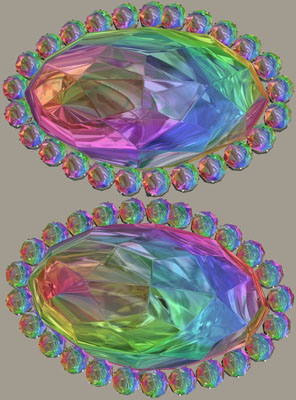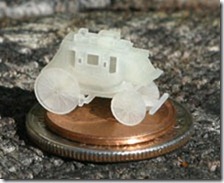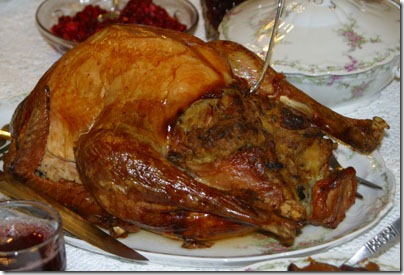Art, Science, Technology D - F
Numbers are indexed as words (3 = three, 8 = eight)
Default Cube: The metallic green default form of the semiconductor device which a Holographic Quantum Dot (HQD) Programmer modifies. The number of semiconductor atoms can be increased or decreased about 10 times. (An Interview With Gina Verucchio) Default Cubes can be manufactured in a wide range of sizes from those suitable for small, household items to large construction materials or even internal features like walls or replacement parts for starships. On a starship, cubes can be teleported from a storage bay as needed and converted to the desired object - like special clothes or gear in an emergency. Default Cubes come in two varieties: Rechargeable and self-charging. Rechargeable cubes are less expensive to purchase. They contain a battery which the user recharges periodically. On a starship, they are often used for temporary items like special chairs and dinnerware for guests. Self-charging cubes are more expensive. They contain electronics for obtaining their power via subspace from the nearest HQD power source. Items programmed from self-charging cubes are sometimes referred to as "self-charges." On a starship, they are often used for reconfigurable walls or other items which need to be low-maintenance. The main drawback is that should the ship lose power, the items revert to their Default Cubes.(Raptors of the Depths) Of course, if a starship loses power problems are likely to be more serious than the loss of some interior walls.
Depropagator Field: The force field produced by the Home Guard fleet which was intended to disrupt the Black Fleet's Warp-Fold Field. (Golden Needles)
Dr. Picadoor's Household Elixir: A phoney cure-all sold by Tom while posing as an itinerant peddler. (Indigo Blue) The name is a part of the anagram ("picador ult") of the random word "duplicator."
Dragger: A type of fishing boat used on Earth and Syringo. On Syringo, they are lighter-than-air craft. (Teasing the Geese)
Dragon Eye: A rare gemstone found on the planet
Taupoi.
Drone: Tiny, unmanned spacecraft carried by and used to examine a larger ship. (Rogue Planet)
Dysprosium: A "rare earth metal" with atomic number 66. It is used in the manufacture of spacecraft on Syringo. (Scary Sheri Safari)
e-Static blanket: The e-static (electrostatic) blanket is a form of argon-glass fabric developed by the Mentecians. Some of the silicon atoms in the glass fibers are replaced by carbon atoms which are components of intermediate to long-chain hydrocarbons. These fibers are intended to be woven into the interior of the fabric.
Flexing of the glass fibers in the fabric causes friction which produces electrostatic charge separation. Because these glass fibers are woven into the interior of the fabric, the charges are insulated from the environment and leak off very slowly. Heat is generated as the charges gradually recombine within the fabric.
Flexing of the fibers can be produced by motions of the user. Originally, the Mentecians used the fabric in their ponchos and walking produced sufficient flexing to make the ponchos desirable cold-weather attire. Eventually, the Mentecians noticed that even ponchos which were motionless were generating warmth. Collision of air molecules with the fabric imparted enough momentum to flex the argon-glass fibers. So the electrostatic fabrics were promoted as blankets, replacing traditional electric blankets. The night-time motions of sleepers combined with the motion of the air in the room produced enough heat for comfort.
Actually, when manufactured to the same specifications as the Mentecian ponchos, many people found the blankets to be uncomfortably warm in the bedroom environment. Conductive fibers were woven into the fabric to bleed off some of the charge. Electrical flow through these fibers produced heat like a traditional electrical blanket or could be routed to the surface where the excess warmth escaped into the air. The temperature under the e-static blanket could be thermostatically controlled.
For psychological reasons, many users found a thicker blanket more comfortable than the original. Altering the flow of charges could cause the O-Si-O-F rings in the argon-glass to change size and configuration, thickening the fabric. Users experienced an effect more like that of snuggling down under a quilt.
Today, e-static blankets come in a variety of colors and patterns. All come with adjustable thermostats and comfort level (thickness) controls.
eBoard: A clip-board version of a Magic Slate (eSlate) (6 June 2403)
ePhone: An older name for the vocophone. (Alien Abduction)
eSlate: see Magic Slate
Eye System: The method of classifying stars by apparent brightness that is used by the Syringee. Stars just visible to the Syringee eye are classified as "1 eye." Stars twice as bright are classified as "2 eye." Stars twice as bright as 2 eye stars are classified as "3 eye," etc. (Do-Si-Do)
Field Collimator: The device which creates and controls a tractor beam. (Monkey Trap)
Floaters: Motorized vehicles which "float" above the ground due to repulsion of silica in the ground. They may also be known as hover vehicles of various sorts (hover car, hover tram, hover truck, etc.)(The Centaurian Bud Vase) (Someday My Prints Will Come).
Food synthesizer:(Do-Si-Do) Printing in 3-D creates an object by "printing out" one layer after another of some material(s) to build up the completed object. The process was developed at the end of the twentieth and beginning of the twenty-first centuries. The initial use was for rapid prototyping: creating prototype objects for industrial use from computer files without the traditional machining process.
 Printing in 3-D quickly went from an industrial process to a consumer process in which toys, jewelry, or other small objects could be created. One company which prints out these things in a variety of media from your 3-D computer model is Shapeways. I had them make saguaro cacti and a stagecoach for my Z-scale Old West model train layout.
Printing in 3-D quickly went from an industrial process to a consumer process in which toys, jewelry, or other small objects could be created. One company which prints out these things in a variety of media from your 3-D computer model is Shapeways. I had them make saguaro cacti and a stagecoach for my Z-scale Old West model train layout.
New Scientist magazine reported on attempts to print out organs from living cells.
 By the time in which my stories take place (the twenty-fourth century and beyond), 3-D printing technology has developed to the point that a food synthesizer can be programmed to print out meals ready to eat from simple inorganic and organic compounds. In this way, food acceptable to any species can be created, doing away with the need to ship native foods from star to star or to keep them under refrigeration for passengers onboard a starship.
By the time in which my stories take place (the twenty-fourth century and beyond), 3-D printing technology has developed to the point that a food synthesizer can be programmed to print out meals ready to eat from simple inorganic and organic compounds. In this way, food acceptable to any species can be created, doing away with the need to ship native foods from star to star or to keep them under refrigeration for passengers onboard a starship.
Food synthesizers can be manufactured in a wide range of sizes, from "industrial strength" models which might print out a roast pig, to restaurant or home models for preparation of individual menu items, to personal models useful for snacks or sandwiches.
FOX: A way to send information by subspace. Often used as a verb (like we use "FAX." (Teasing the Geese)
Page updated: 21 October 2021
Page created: 19 January 2012